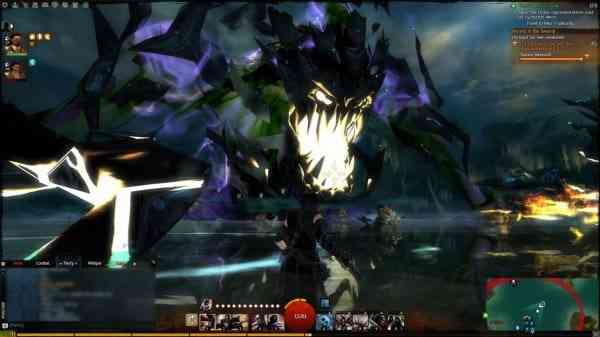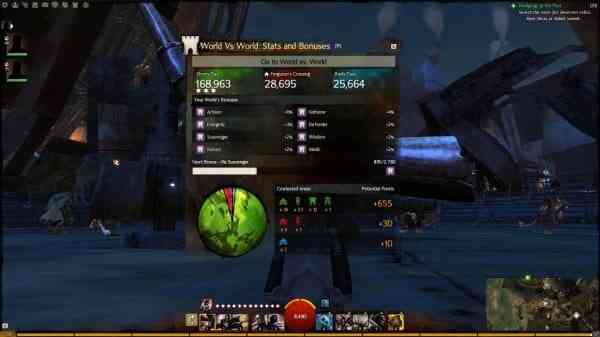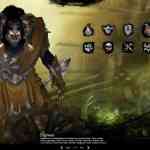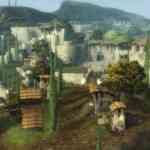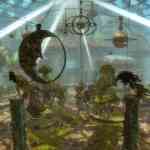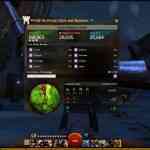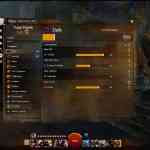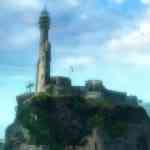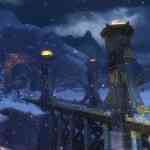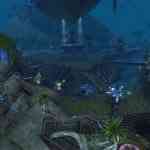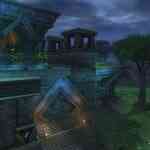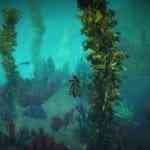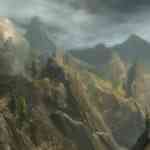Over 5 years ago, ArenaNet, the makers of the original Guild Wars which I enjoyed immensely, announced they had begun production of the sequel to their popular game. As of August 28th, 2012, after years of hype and developer blogs outlining a redefining of the MMO genre, it was officially released to the masses. I have, however, tried to be thorough in my gameplay/exploration in the time I have played about 120 hours over multiple characters, so as to give a decent impression of as many facets as possible, but I am sure I have missed some things, so please, be kind to me.
Guild War 2’s story takes place 250 years after the original in the same world where it began. With that in mind, although many of the settings are similar from the first game they have aged/changed over time with 250 years of progress. This is quite neat because it adds some nostalgia to the game world while at the same time keeping it new and exciting. It also means there are new technology and items to use such as pistols, rifles, and turrets for the engineers. If you played the original Guild Wars game you have the option to link your accounts together (GW 1 and GW 2), and based on the achievements of your characters in the first game, you will unlock special armour skins and items that your new characters to have access too. As it is a “live” connection, you can still go back to the original game to complete more achievements and unlock further Guild Wars 2 items.
As with most games, the first thing you experience when you enter the world of Tyria is the art style. Beginning from the point of Character Creation, you will see how the designers wanted to focus on having a style based off of the painted concept art. This is apparent from the hand painted backgrounds and overlays populating the character creation screens and storyline movies to the character cut-scenes with the interacting characters placed over a simple painted background to highlight the dialogue.
Although the game may be running on a bit of an older engine using DirectX 9, the vivid colours and the painted textures really bring the world to life. The designers have also done an amazing job of making each area of the world unique to the species that inhabit it while also seamlessly blending the explorable areas so that there is no harsh border. I was amazed at how unique and alive the cities and areas are. Walking through the streets of the cities, you will come across dozens of unique conversations that you can either stroll right past, or stop and listen to get an idea of other facets of the Tyrian storyline or the daily life in the village. As you wander, you will notice that even in the large cities, very rarely do you come across a duplicated building, which really helps with the immersion into the game world.
A big point of controversy when the developers were releasing information about the game was the redesign of the character skill bar. Instead of building your skill bar from all of the skills you acquire, half of your skill bar (slots 1-5) is now populated based on the weapons in your hands. Slot 6 is a healing skill now that there are no longer monks in the game. Slots 7-9 are unlocked as you level up (levels 5, 10 and 20 respectively) and they are populated by various skills you purchase through earned skill points. Last but not least, Slot 0 is unlocked at level 30 and here you insert an elite skill. At level 11, you also get to unlock the ability to add trait points to boost… well… traits of your character such as vitality (health), power (damage dealt), precision (accuracy), etc. You do this by finding the trainer associated with your chosen profession.
One of the major advancements touted by the developers was the increasingly dynamic game world. No longer do you run around finding quest givers in order to progress through the ranks. This time around as you explore your setting world dynamic events happen all around you allowing you to jump in and out of battle whenever you desire. No longer do you have to kill ‘X’ number of enemies to finish a quest/event. Just complete as much as you want and the game will grade you on your participation and reward you on your performance (bronze, silver, gold). This system isn’t perfect as the odd one still has the “fetch-quest” feeling. I also found that once in a while, mainly during a large boss battle after you have been fighting the boss for what could be up to 5 minutes or so, you still get rewarded with a bronze medal making you question your participation. One really nice aspect of this new system however is that it gives you the freedom to just explore. You are no longer burdened by opening up a Quest Log just to cringe as you try to sort through the dozen or so you still have remaining from previous areas that you may never go back to anyway.
The other advancement with this dynamic system is how it can affect parts of the game world. In one of the areas Centaurs are constantly attacking outposts held by the Seraph (a protection force). If players don’t stop the attacks by the Centaurs then the Centaurs can take over the outpost and will become more prevalent in the area. When this happens the benefits of the outpost (e.g. such as merchants) disappear leaving the players with less options and safe areas in the game world. If the Centaurs are in control, and the players are able to help the Seraph eradicate the Centaur threat, then the Seraph will re-take control of the outpost and re-establish benefits (e.g. the merchant).
Along with the quests and events, each character also has a personal storyline which progresses through the game world. The storyline that your character follows is driven by the choices you made during character creation and each race has a unique set of storylines. As you advance through your story you are required to make certain choices that will take you through different branches of the story.
The developers also designed the game around the game-playing community working and playing together. A big help to this ideal are how loot drops are unique to the players, not the downed creature. Even if three people attack a creature together, all three may receive loot once the creature has been defeated. This allows for the community to play together as there is no competition or fighting for items. The other nice thing is the ability to resurrect fallen adventurers. A special icon will show up above the character or on your map alerting you to someone who has died or is near death in the area so that you can go assist them. This sound simple but I found it a great “assist” when playing.
I have never been a big peer versus peer player, but I did jump into some World versus World (WvW) play. I can see the appeal as it was a completely different experience playing with and against dozens of other players, but at the same time it was a lot more chaotic. They have set up the WvW map as a big strategy game with teams from three of the game’s world servers battling to accumulate points based on landmarks being held by each team. As your server accumulates points it unlocks boosts/boons for your home server in areas such as crafting, finding rare items, additional harvesting nodes, etc. I found at certain times I spent more effort just dodging Area of Effect spells than actually trying to fight/destroy enemies and/or landmarks. I may try to spend more time playing WvW once I have completed everything in the core of the game. I do admit that I found it hard to get into WvW and a bit less rewarding for my tastes at this point. That being said, if you are an avid Peer versus Peer player in games, you will most likely appreciate it a lot more as you can tell a lot of effort has been put into it. The game also has a more standard PvP mode, but WvW does a lot more to put a new element into the gameplay.
The economy of Guild Wars 2 supports three currencies, Gold, Karma and Gems. Gold is the basic in-game currency and is earned as you complete quests, sell loot, and conduct other transactions within the game world. It is used to buy most of the armour, weapons, and items that you come across at most vendors. Karma is earned by completing quest hearts and other events. You can spend karma at special vendors to buy rarer items, such as certain crafting items and rare armour and weapons with boosted stats. Gems are used for the in-game store to purchase a few cosmetic items (armour skins, mini-pets, etc). You can also purchase some items with real money or they can be traded on the currency exchange using your characters in-game gold. Gold and gems can be traded for each other at any time on the currency exchange. I found this makes for a good balance of paying money for items that you may want, or investing time if you don’t want to pay for anything.
One highlight of Guild Wars 2 is the inventory management that ArenaNet has implemented. Your character begins with a starter backpack and four character storage slots are available that accept various bags along with 1 bank slot. If you decide that isn’t enough you can use Gem currency to increase the number of available character bags or storage slots. Character bag sizes are also upgradable through crafted bags that you can create or purchase on the Trading Post. The inventory display is pretty basic and similar to any other MMO out there, but the management features they have enabled make this wonderful to work with. Every account is equipped with a bank which includes a standard inventory tab along with a “Collectibles” tab which stores up to 250 of each of the hundreds of basic crafting elements. As the bank is game account based, it makes it very easy to share resources amongst all of your characters. Putting your collectibles into your bank can be accomplished at any time by either right-clicking on the item, or clicking on the gear icon in your inventory tab and selecting “Deposit Collectibles”. This comes in very handy when you are out adventuring and your inventory slots are filling up. Just make sure you keep salvage kits available as well to clear out any other required spaces.
The original Guild Wars made use of a trade window in order to allow players to trade and sell items, but a few exploits started cropping up and certain players were getting cheated out of their items/gold. In Guild Wars 2, ArenaNet has now implemented a full Trading Post system which is very easy to use. If you are looking to buy items, it’s a matter of just opening the panel, searching for items in a box that will auto-fill as you type, making sure you narrow down the item properly, and once you buy your items you can just find a trading post in any city, or a few scattered through the world, and pick up your purchases. To sell items, you can either open the trading panel and it will give you a list of sellable items, or you can just right-click on an item in your inventory and post it to the trading post. Once the item sells, you will be notified and, again, you travel to a trading post and collect your earnings.
The original Guild Wars game relied on salvaging items and drops to get the items you needed to trade in to make certain armours or items. Guild Wars 2 introduces a much more elaborate harvesting and crafting system this time around. You can still salvage, but this time around you will find ore nodes, trees to chop down, and plants that you can harvest. All of these nodes will yield core crafting items that you can save and use according to the crafting disciplines you choose. The nice thing with these nodes is that they are harvestable by all players. Once you collect a node and it disappears from your screen, other players will still be able to run over and gain the benefits themselves. Again, another way which limits competition between characters as you won’t see the nodes get taken just as you are on your way to collect it.
A common problem in a few MMOs is finding weapons that you like the appearance of, but the stats aren’t very good, or vice-versa. A neat solution to this is that once in a while you will receive Transmutation Stones which allow you to select two like items (swords, pistols, jackets, etc.), you then pick and choose the preferred attributes of each and then combine the two objects into one. You can also purchase these stones on the gem store.
In the original game map exploration was done by uncovering every square inch of the map, small section by small section as you ran around. Once you made it into the high 90% range it was more difficult (read: frustrating) to keep finding those one or two small areas that you hadn’t walked on yet. In Guild Wars 2, the developers have addressed this by altering the way you complete the exploration of an area. Now, each zone or city contains waypoints, activity hearts, skill points, points of interest and vistas. As the map highlights completion of each one of these elements in the area you are in it is much less frustrating to monitor completion of each area as you adventure.
Guild Wars 2 also rewards the player with achievement points. For example, you receive the points for dozens of goals ranging from enemy kills, PvP kills, harvesting and item salvaging. In line with the community aspect of the game, you even get achievements for helping other players fight creatures and reviving players who have gone down. There are also goals to meet daily and monthly which help boost your achievement tally. I liked this feature as it gave me goals to try to achieve.
The audio is this game does not disappoint. The excellent orchestral soundtrack by Jeremy Soule, which includes music from the previous Guild Wars game along with some newly arranged pieces, does a great job of complementing the areas and gameplay. The sound engineers also did a great job with the sound effects. From the ambient noises as you explore the cities to the sounds effects of your weapons and spells, it really brings life to the action.
If you have been able to make it this far in my review, and anything you read has intrigued or excited you about this game, you owe it to yourself to pick up a copy as you will not be sorry. The improvements are many, the story is enjoyable, and the gameplay is pretty refined; all of these make Guild Wars 2 a game worth playing. Oh, and ‘May the Six watch over you’.


